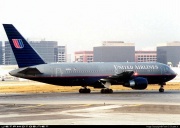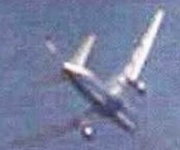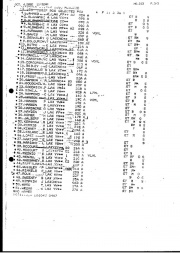World Trade Center
Aus 9/11 Wiki
(→kritische Stimmen) |
|||
| (Der Versionsvergleich bezieht 23 dazwischenliegende Versionen mit ein.) | |||
| Zeile 1: | Zeile 1: | ||
| + | |||
| + | ==Tatwaffen== | ||
| + | Unter [[Tatwaffe: Flugzeug]] finden Sie weitere Informationen zu den Flugzeugen, die an 9/11 als Tatwaffen benutzt wurden. | ||
[[Datei:Ua175.gif|miniatur|Flugbewegungen von UA175]] | [[Datei:Ua175.gif|miniatur|Flugbewegungen von UA175]] | ||
[[Datei:Ua175 precrash.jpg|miniatur|Bild von UA175 auf dem Rollfeld]] | [[Datei:Ua175 precrash.jpg|miniatur|Bild von UA175 auf dem Rollfeld]] | ||
| Zeile 5: | Zeile 8: | ||
[[Datei:Flight 175 Manifest a small.jpg|miniatur|Die umstrittene Kopie der Passagierliste von UA175]] | [[Datei:Flight 175 Manifest a small.jpg|miniatur|Die umstrittene Kopie der Passagierliste von UA175]] | ||
| - | |||
| - | + | ==Fragenkatalog== | |
| - | + | *[[Wurden die Twintowers und WTC7 gesprengt?]] | |
| - | + | *[[Gibt es Hinweise die eine noplane-Theorie am WTC stützen?]] | |
| - | + | ||
| - | + | ||
| - | + | ||
| - | + | ||
| - | + | ||
| - | + | ||
| - | + | ||
| - | + | ||
| - | + | ||
| - | + | ||
| - | + | ||
| - | + | ||
| - | + | ||
| - | + | ||
| - | + | ||
| - | + | ||
| - | + | ||
| - | + | ||
| - | + | ||
| - | + | ||
| - | + | ||
| - | + | ||
| - | + | ||
| - | + | ||
| - | + | ||
| - | + | ||
| - | + | ||
| - | + | ||
| - | + | ||
| - | + | ||
| - | + | ||
| - | + | ||
| - | + | ||
| - | + | ||
| - | + | ||
| - | + | ||
| - | + | ||
| - | + | ||
| - | + | ||
| - | + | ||
| - | + | ||
| - | + | ||
| - | + | ||
| - | + | ||
| - | + | ||
| - | + | ||
| - | + | ||
| - | + | ||
| - | + | ||
| - | + | ||
| - | + | ||
| - | + | ||
| - | + | ||
| - | + | ||
| - | + | ||
| - | + | ||
| - | + | ||
| - | + | ||
| - | + | ||
| - | + | ||
| - | + | ||
| - | + | ||
| - | + | ||
| - | + | ||
| - | + | ||
| - | + | ||
| - | + | ||
| - | + | ||
| - | + | ||
| - | + | ||
| - | + | ||
| - | + | ||
| - | + | ||
| - | + | ||
| - | + | ||
| - | + | ||
| - | + | ||
| - | + | ||
| - | + | ||
| - | + | ||
| - | + | ||
| - | + | ||
| - | + | ||
| - | + | ||
| - | + | ||
| - | + | ||
| - | + | ||
| - | + | ||
| - | + | ||
| - | + | ||
| - | + | ||
| - | + | ||
| - | + | ||
| - | + | ||
| - | + | ||
| - | + | ||
| - | + | ||
| - | + | ||
| - | + | ||
| - | + | ||
| - | + | ||
| - | + | ||
| - | + | ||
| - | + | ||
| - | + | ||
| - | + | ||
| - | + | ||
| - | + | ||
| - | + | ||
| - | + | ||
| - | + | ||
| - | + | ||
| - | + | ||
| - | + | ||
| - | + | ||
| - | + | ||
| - | + | ||
| - | + | ||
| - | + | ||
| - | + | ||
| - | + | ||
| - | + | ||
| - | + | ||
| - | + | ||
| - | + | ||
| - | + | ||
| - | + | ||
| - | + | ||
| - | + | ||
| - | + | ||
| - | + | ||
| - | + | ||
| - | + | ||
| - | + | ||
| - | + | ||
| - | + | ||
| - | + | ||
| - | + | ||
| - | + | ||
| - | + | ||
==kritische Stimmen== | ==kritische Stimmen== | ||
| + | |||
| + | '''Stabile Struktur'''<br /> | ||
| + | Laut der FEMA waren die Twin Towers<br /> | ||
| + | ''"the first structures outside of the military and nuclear industries whose design considered the impact of a jet airliner, the Boeing 707."'' <ref>https://books.google.de/books?id=PJ3bfaDVcvMC&pg=SA1-PA17&lpg=SA1-PA17&dq=the+first+structures+outside+of+the+military+and+nuclear+industries+whose+design+considered+the+impact&source=bl&ots=e1G0r5ERcD&sig=brKv7tHVgxdeMDXpHtB3lNk7i6E&hl=de&sa=X&ei=yVweVaqUHcOOsAHdl4HIAw&ved=0CC4Q6AEwAQ#v=onepage&q=the%20first%20structures%20outside%20of%20the%20military%20and%20nuclear%20industries%20whose%20design%20considered%20the%20impact&f=false|</ref><br /> | ||
| + | |||
'''Crash einkalkuliert'''<br /> | '''Crash einkalkuliert'''<br /> | ||
"The building was designed to have a fully loaded 707 crash into it. That was the largest plane at the time. I believe that the building probably could sustain multiple impacts of jetliners because this structure is like the mosquito netting on your screen door - this intense grid - and the jet plane is just a pencil puncturing that screen netting. It really does nothing to the screen netting." | "The building was designed to have a fully loaded 707 crash into it. That was the largest plane at the time. I believe that the building probably could sustain multiple impacts of jetliners because this structure is like the mosquito netting on your screen door - this intense grid - and the jet plane is just a pencil puncturing that screen netting. It really does nothing to the screen netting." | ||
| Zeile 161: | Zeile 28: | ||
'''Brände'''<br /> | '''Brände'''<br /> | ||
| - | "We have assumed that the entire 3,500 gallons of jet fuel was confined to just one floor of the World Trade Center, that the jet fuel burnt with perfect efficency, that no hot gases left this floor, that no heat escaped this floor by conduction and that the steel and concrete had an unlimited amount of time to absorb all the heat. Then it is impossible that the jet fuel, by itself, raised the temperature of this floor more than 257°C (495°F)." | + | "We have assumed that the entire 3,500 gallons of jet fuel was confined to just one floor of the World Trade Center, that the jet fuel burnt with perfect efficency, that no hot gases left this floor, that no heat escaped this floor by conduction and that the steel and concrete had an unlimited amount of time to absorb all the heat. Then it is impossible that the jet fuel, by itself, raised the temperature of this floor more than 257°C (495°F)."<ref>http://911research.wtc7.net/mirrors/guardian2/wtc/how-hot.htm</ref> |
| - | + | ||
| + | Donovan Cowan was in an open elevator at the 78th floor sky-lobby (one of the impact floors of the South Tower) when the aircraft hit. He has been quoted as saying: "We went into the elevator. As soon as I hit the button, that's when there was a big boom. We both got knocked down. I remember feeling this intense heat. The doors were still open. The heat lasted for maybe 15 to 20 seconds I guess. Then it stopped." | ||
| + | |||
| + | Stanley Praimnath was on the 81st floor of the South Tower: "The plane impacts. I try to get up and then I realize that I'm covered up to my shoulder in debris. And when I'm digging through under all this rubble, I can see the bottom wing starting to burn, and that wing is wedged 20 feet in my office doorway." | ||
| + | |||
| + | Ling Young was in her 78th floor office: "Only in my area were people alive, and the people alive were from my office. I figured that out later because I sat around in there for 10 or 15 minutes. That's how I got so burned." | ||
'''Geschmolzenes Metall'''<br /> | '''Geschmolzenes Metall'''<br /> | ||
| Zeile 182: | Zeile 54: | ||
Symmetrie <br /> | Symmetrie <br /> | ||
Fallgeschwindigkeit <br /> | Fallgeschwindigkeit <br /> | ||
| - | |||
==Quellen und weiterführende Links== | ==Quellen und weiterführende Links== | ||
| - | + | <references/> | |
'''Quellen''' | '''Quellen''' | ||
| - | # [ | + | # [http://911research.wtc7.net/mirrors/guardian2/wtc/how-hot.htm] |
| - | # [ | + | # [http://www.sas.upenn.edu/sasalum/newsltr/summer2002/k911.html] |
# [http://www.philly.com/mld/dailynews/news/local/10033802.htm| http:/www.philly.com/mld/dailynews/news/local/10033802.htm] | # [http://www.philly.com/mld/dailynews/news/local/10033802.htm| http:/www.philly.com/mld/dailynews/news/local/10033802.htm] | ||
# [http://www.washingtonpost.com/wp-dyn/content/article/2006/03/31/AR2006033100978.html| http://www.washingtonpost.com/wp-dyn/content/article/2006/03/31/AR2006033100978.html] | # [http://www.washingtonpost.com/wp-dyn/content/article/2006/03/31/AR2006033100978.html| http://www.washingtonpost.com/wp-dyn/content/article/2006/03/31/AR2006033100978.html] | ||
| Zeile 194: | Zeile 65: | ||
# [http://loosechange911.blogspot.com/2007/02/open-letter.html| Anonym, E-Mail Loose Change Blog, 7.2.2007] | # [http://loosechange911.blogspot.com/2007/02/open-letter.html| Anonym, E-Mail Loose Change Blog, 7.2.2007] | ||
# [http://www.prisonplanet.com/articles/september2007/130907_demolition_countdown.htm| Kevin McPadden, Interview Prison Planet, 13.9.2007] | # [http://www.prisonplanet.com/articles/september2007/130907_demolition_countdown.htm| Kevin McPadden, Interview Prison Planet, 13.9.2007] | ||
| + | # [https://books.google.de/books?id=PJ3bfaDVcvMC&pg=SA1-PA17&lpg=SA1-PA17&dq=the+first+structures+outside+of+the+military+and+nuclear+industries+whose+design+considered+the+impact&source=bl&ots=e1G0r5ERcD&sig=brKv7tHVgxdeMDXpHtB3lNk7i6E&hl=de&sa=X&ei=yVweVaqUHcOOsAHdl4HIAw&ved=0CC4Q6AEwAQ#v=onepage&q=the%20first%20structures%20outside%20of%20the%20military%20and%20nuclear%20industries%20whose%20design%20considered%20the%20impact&f=false| FEMA - World Trade Center Building Performance Study ] | ||
'''weiterführende Links''' <br /> | '''weiterführende Links''' <br /> | ||
| Zeile 199: | Zeile 71: | ||
# [http://911research.wtc7.net/mirrors/guardian2/wtc/godfrey.htm| Umfangreicher Artikel zur Architektur des WTC]<br /> | # [http://911research.wtc7.net/mirrors/guardian2/wtc/godfrey.htm| Umfangreicher Artikel zur Architektur des WTC]<br /> | ||
# [http://911research.wtc7.net/essays/reynolds/index.html| Kritische Betrachtungen zu den Noplane-Theorien]<br /> | # [http://911research.wtc7.net/essays/reynolds/index.html| Kritische Betrachtungen zu den Noplane-Theorien]<br /> | ||
| + | |||
| + | |||
| + | |||
| + | |||
| + | [[Kategorie:!Hauptkategorie]][[Kategorie:Tatorte]][[Kategorie:Gebäude]] | ||
Aktuelle Version vom 3. April 2015, 09:38 Uhr
Inhaltsverzeichnis |
Tatwaffen
Unter Tatwaffe: Flugzeug finden Sie weitere Informationen zu den Flugzeugen, die an 9/11 als Tatwaffen benutzt wurden.
Fragenkatalog
kritische Stimmen
Stabile Struktur
Laut der FEMA waren die Twin Towers
"the first structures outside of the military and nuclear industries whose design considered the impact of a jet airliner, the Boeing 707." [1]
Crash einkalkuliert
"The building was designed to have a fully loaded 707 crash into it. That was the largest plane at the time. I believe that the building probably could sustain multiple impacts of jetliners because this structure is like the mosquito netting on your screen door - this intense grid - and the jet plane is just a pencil puncturing that screen netting. It really does nothing to the screen netting."
— Frank A. Demartini, Bauleiter des World Trade Center
Stahlträger
"We know that the steel components were certified to ASTM E119. The time temperature curves for this standard require the samples to be exposed to temperatures around 2000F for several hours. And as we all agree, the steel applied met those specifications. Additionally, I think we can all agree that even un-fireproofed steel will not melt until reaching red-hot temperatures of nearly 3000F. Why Dr. Brown would imply that 2000F would melt the high-grade steel used in those buildings makes no sense at all."
— Kevin Ryan, Underwriters Laboratories
Brände
"We have assumed that the entire 3,500 gallons of jet fuel was confined to just one floor of the World Trade Center, that the jet fuel burnt with perfect efficency, that no hot gases left this floor, that no heat escaped this floor by conduction and that the steel and concrete had an unlimited amount of time to absorb all the heat. Then it is impossible that the jet fuel, by itself, raised the temperature of this floor more than 257°C (495°F)."[2]
Donovan Cowan was in an open elevator at the 78th floor sky-lobby (one of the impact floors of the South Tower) when the aircraft hit. He has been quoted as saying: "We went into the elevator. As soon as I hit the button, that's when there was a big boom. We both got knocked down. I remember feeling this intense heat. The doors were still open. The heat lasted for maybe 15 to 20 seconds I guess. Then it stopped."
Stanley Praimnath was on the 81st floor of the South Tower: "The plane impacts. I try to get up and then I realize that I'm covered up to my shoulder in debris. And when I'm digging through under all this rubble, I can see the bottom wing starting to burn, and that wing is wedged 20 feet in my office doorway."
Ling Young was in her 78th floor office: "Only in my area were people alive, and the people alive were from my office. I figured that out later because I sat around in there for 10 or 15 minutes. That's how I got so burned."
Geschmolzenes Metall
Die ersten Hinweise auf geschmolzenes Metall kamen bereits Stunden nach dem Unglück von den Such- und Rettungsmannschaften. So zum Beispiel von Sarah Atlas die mit Ihrer Hündin Anna 10 Tage lang an Ground Zero nach Überlebenden suchte.2
Flugschreiber
Feuerwehrmann Nicholas DeMasi berichtete in einem von Arbeitern an Ground Zero selbst verlegten Buch, dass er im Oktober 2001 zusammen mit Bundesagenten drei der vier Flugdatenschreiber der beiden Unglücksmaschinen gefunden habe. Nach offizieller Darstellung wurden hingegen keine Flugdatenschreiber geborgen.3
Notrufe und Feuerwehr-Funkverkehr
Am 31. März 2006 veröffentlichte die Washington Post die Transkripts und einige Audio-Ausschnitte der 911-Notrufe vom 11. September 2001. Leider sind die Worte der Anrufer nicht wiedergegeben.4
Controlled Demolition
Steven E. Jones ist einer der bekanntesten Vertreter der Sprengungstheorie und hat einen Artikel mit dem Titel "Why Indeed Did the WTC Buildings Completely Collapse?" verfasst. Seiner Meinung nach wurde zur Sprengung der Twin Tower Thermate verwendet.5
Explosionen
Squibs
Betonpulverisierung
Staubvolumen
Zerkleinerter Stahl
Symmetrie
Fallgeschwindigkeit
Quellen und weiterführende Links
- ↑ https://books.google.de/books?id=PJ3bfaDVcvMC&pg=SA1-PA17&lpg=SA1-PA17&dq=the+first+structures+outside+of+the+military+and+nuclear+industries+whose+design+considered+the+impact&source=bl&ots=e1G0r5ERcD&sig=brKv7tHVgxdeMDXpHtB3lNk7i6E&hl=de&sa=X&ei=yVweVaqUHcOOsAHdl4HIAw&ved=0CC4Q6AEwAQ#v=onepage&q=the%20first%20structures%20outside%20of%20the%20military%20and%20nuclear%20industries%20whose%20design%20considered%20the%20impact&f=false|
- ↑ http://911research.wtc7.net/mirrors/guardian2/wtc/how-hot.htm
Quellen
- [1]
- [2]
- http:/www.philly.com/mld/dailynews/news/local/10033802.htm
- http://www.washingtonpost.com/wp-dyn/content/article/2006/03/31/AR2006033100978.html
- http://www.scholarsfor911truth.org/WhyIndeedDidtheWorldTradeCenterBuildingsCompletelyCollapse.pdf
- Anonym, E-Mail Loose Change Blog, 7.2.2007
- Kevin McPadden, Interview Prison Planet, 13.9.2007
- FEMA - World Trade Center Building Performance Study
weiterführende Links




